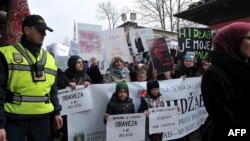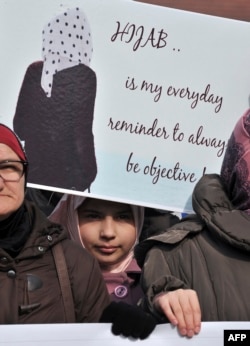Bosnia-Herzegovina's supervising judicial authority has upheld a ban on wearing the Islamic head scarf and other religious symbols in courts and other legal institutions.
The decision to uphold the ban on the hijab was announced by the High Judicial and Prosecutorial Council (HJPC) on February 11 and came despite weekend protests in the capital and several other Bosnian towns.
It applies to judges and other employees in the Bosnian judiciary and pertains to all religious symbols and garb. But it explicitly mentions the hijab -- the Islamic head scarf that leaves the face open while covering the hair, ears, and neck.
The council, which supervises the functioning of the judiciary, announced the measure in October. But the measure went largely unnoticed until it went into effect some two weeks ago, prompting criticism and mass protests.
The largest protest took place on February 7 in Sarajevo, where some 2,000 people, mostly women, held a one-hour demonstration in support of their right to wear the hijab.
Many of the female demonstrators held banners with various slogans supporting the wearing of the hijab, including: "The Hijab Is My Right" and "The Hijab Is My Life."
Speaking on February 10, council President Milan Tegeltija sought to allay the tensions, saying they had been prompted by a misunderstanding.
Tegeltija said the council was only acting in accordance with the ruling adopted in October.
He explained that the ban was needed to maintain the image of the courts as impartial arbiters.
"No one is stating that, by wearing a religious symbol, a member of the judiciary is biased," he was quoted as saying by Indian daily Siasat.
But he added that the presence of such symbols could prompt those under trial to accuse the judiciary of lacking neutrality.
Tegeltija, quoted by the Vijesti.ba website, reiterated that the decision refers to all religious symbols, although the public protests centered only on the hijab.
In singling out the Islamic head scarf, the measure states that lawyers, court officials, and other judicial system employees will no longer be allowed to wear the hijab to work.
It also says that allowing witnesses and other third parties taking part in hearings to wear a head scarf would be decided on a case-by-case basis.
Critics have pointed out that while a Christian cross can be removed or concealed, the same is not true for a hijab.
It was the first time Bosnia-Herzegovina, which was part of the former Yugoslavia and whose population of 3.8 million is about 40 percent Muslim, has ruled on the wearing of the hijab.
Yugoslavia's communist rulers after World War II banned the wearing of a different type of Muslim head scarf, the niqab, which covers a woman's face almost completely, with the exception of the eyes.
The hijab ruling has been condemned by Muslim political and religious leaders in the country.
Several petitions have been posted online calling for the measure to be scrapped.
And on the occasion of World Hijab Day, an annual event held this year on February 1 that encourages Muslim and non-Muslim women to wear the hijab, Bosnian activists posted pictures of themselves wearing the head scarf and holding the sign #unbiased.
Tegeltija said that the head of Bosnia's Muslim community, Husein Kavazovic, has told the council that he is interested in cooperating with the body.
To reduce tensions, Tegeltija also proposed holding talks with leaders of Bosnia's Muslim and other religious communities, which in Bosnia includes Orthodox and Catholic Christians.
Another European country that partially forbids religious symbols is France, which banned them from public schools in 2004. In 2010, France also prohibited the concealing of a person's face in public, resulting in a ban on the wearing of face-covering headgear, including niqabs and other veils, except under specific circumstances.

